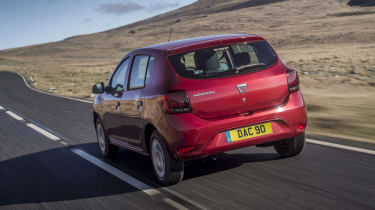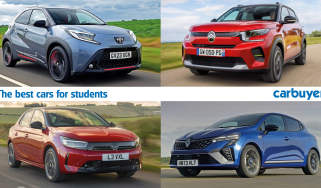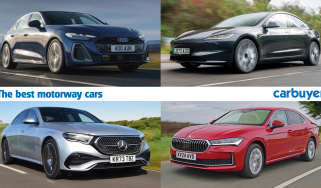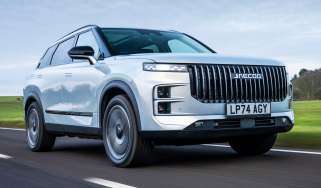Dacia Sandero hatchback review (2013-2020)
"The Dacia Sandero is incredibly good value, with low running costs and great practicality – but don’t expect lavish materials or polished fit and finish"
Pros
- Incredible value for money
- Cheap to run
- Big boot
Cons
- Very dull design
- Interior feels cheap
- Not much fun to drive
Many car brands offer a unique selling point, such as design, quality or driving pleasure, but from the moment Dacia arrived in the UK, they offered buyers one thing ahead of anything else: ultra low prices. With the launch of the Dacia Sandero hatchback in 2013, the manufacturer offered buyers a brand new car for the price of a used one.
To this day, Dacia has kept their promise of offering fantastic value for money with the Sandro remaining the cheapest car on sale in the UK. What’s more, the Romanian brand’s smallest car is actually a practical supermini similar in size to a Ford Fiesta or Kia Rio. Also, it's low starting price helps it undercut more expensive city cars such as the Hyundai i10, Kia Picanto, Toyota Aygo and Peugeot 108.
Many of its rivals are modern cars boasting an array of equipment, up to date safety tech and frugal fuel economy. By comparison, the Sandero is fairly low tech. As it takes many of its parts from discontinued models previously produced by Renault, Dacia’s parent company. In fact, the Sandero is based on the older versions of the Renault Clio.
On the plus side, all this component sharing means the Sandero is well proven. Not only that, but it’s actually well built. It lacks the usual indications of good quality we expect, such as a luxurious interior and smart materials, but in all other respects it’s a quality car. In addition, its 0.9-litre turbocharged petrol engine is bang up-to-date.
It may not be the prettiest car on the road but the Sandero is distinctive in a good way, while versions higher up the range have nice exterior touches such as alloy wheels that give the model a lift. All versions have attractive LED daytime running lights at the front, too. Only the basic Access version really communicates the Sandero’s budget status with its grey bumpers and the one non-metallic colour choice.
More reviews
This impression continues inside, where style very much plays second fiddle to simplicity and sturdiness. This is especially true of the Access, where the uninitiated may spend a few head-scratching moments looking for the radio and electric window controls – a fruitless quest, as these are only fitted to the Essential trim level and above. The same goes for central locking and air-conditioning. However, the sparse standard kit of the Access begins to make sense when you realise it undercuts even the cheapest Kia Picanto city car by £3,000. In terms of monthly finance deals, you can get a brand-new Access for under £100 per month.
In truth, few customers plump for the Access, as the Essential has all that’s missing from the cheaper model, is rather more attractive thanks to body-coloured bumpers, has a wider range of engines and still offers striking value for money. And, for not a lot more, you can choose the range-topping Comfort, with its seven-inch touchscreen infotainment system, sat nav, cruise control and parking sensors – a Ford Fiesta Titanium-rivalling package for the cost of an entry-level Ford Ka+.
The choice of engines is limited, but all have been well proven in Renault models. Although the 1.0-litre SCe petrol is a rather simple design, the turbocharged 0.9-litre TCe uses modern technology to improve economy and reduce emissions. The latter also has more power at 89bhp, a useful increase over the smaller engine’s 74bhp. It’s more expensive to buy, though, and many will find the less powerful engine perfectly acceptable for short journeys or urban trips. The 1.0-litre SCe 75 and 0.9-litre TCe 90 engine return up to 48.8mpg and 47mpg respectively.
In early 2020, the Sandero engine line-up was refreshed. The Blue dCi diesel engine was discontinued and replaced by a new 1.0-litre petrol/LPG engine producing 99bhp. Badged as the TCe 100 Bi-Fuel, this engine can be specced in Essential and Comfort trim cars, and is capable of up to 49.5mpg when running on petrol or up to 39.7mpg on LPG.
Whichever engine you go for, you’ll find the Sandero pleasant to drive, rather than inspiring. It’s comfortable – the suspension is soft and urban potholes are dispatched as easily as motorway bumps. It’s somewhat prone to body lean in corners, though, and doesn’t spur you on to drive enthusiastically.
Its role is more to provide fuss-free, good-value family transport than entertainment, but in this respect its four-star Euro NCAP safety rating risks putting buyers off. However, while a longer list of safety equipment gives many rival cars a higher five-star rating, the Sandero’s crash performance was actually very good in testing. Adult occupant protection was rated as 79%, with child protection scoring 80%.
Sandero ownership can be a mixed bag, it seems. It didn’t appear in our 2020 Driver Power owner satisfaction survey, but it ranked last among 75 cars tested in 2018, with reliability rated well below average. A big plus, though, was its excellent rating for fuel consumption and running costs.
Overall, if ever there was a car where ‘you get what you pay for’, this is it. We can’t help but feel, though, that its appeal is greater than the sum of its distinctly ordinary parts.














